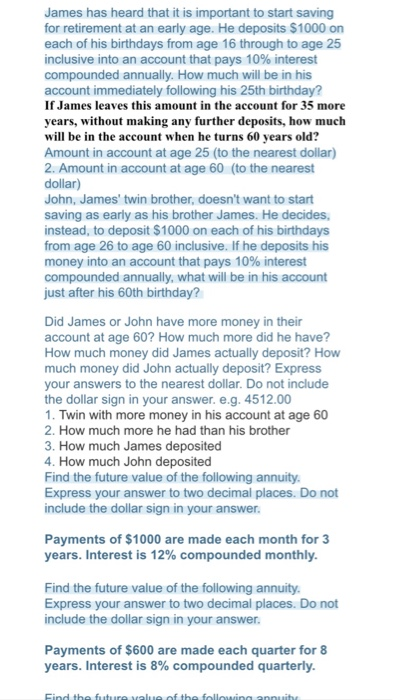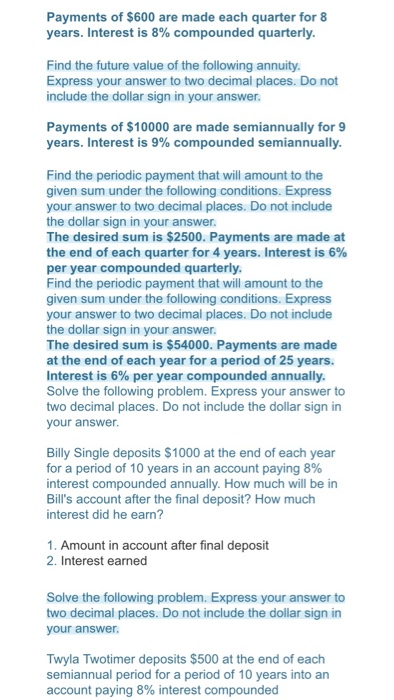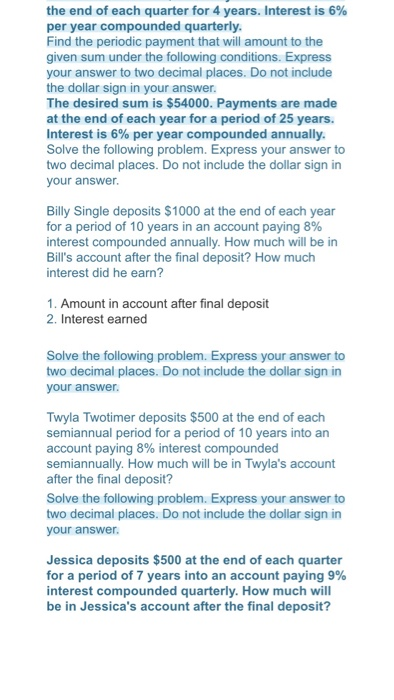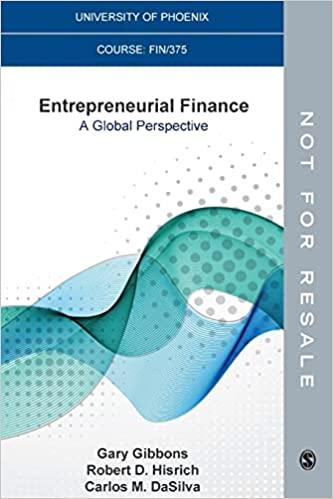James has heard that it is important to start saving for retirement at an early age. He deposits $1000 on each of his birthdays from age 16 through to age 25 inclusive into an account that pays 10% interest compounded annually. How much will be in his account immediately following his 25th birthday? If James leaves this amount in the account for 35 more years, without making any further deposits, how much will be in the account when he turns 60 years old? Amount in account at age 25 (to the nearest dollar) 2. Amount in account at age 60 (to the nearest dollar) John, James' twin brother, doesn't want to start saving as early as his brother James. He decides, instead, to deposit $1000 on each of his birthdays from age 26 to age 60 inclusive. If he deposits his money into an account that pays 10% interest compounded annually, what will be in his account just after his 60th birthday? Did James or John have more money in their account at age 60? How much more did he have? How much money did James actually deposit? How much money did John actually deposit? Express your answers to the nearest dollar. Do not include the dollar sign in your answer. e.g. 4512.00 1. Twin with more money in his account at age 60 2. How much more he had than his brother 3. How much James deposited 4. How much John deposited Find the future value of the following annuity. Express your answer to two decimal places. Do not include the dollar sign in your answer Payments of $1000 are made each month for 3 years. Interest is 12% compounded monthly. Find the future value of the following annuity. Express your answer to two decimal places. Do not include the dollar sign in your answer. Payments of $600 are made each quarter for 8 years. Interest is 8% compounded quarterly Payments of $600 are made each quarter for8 years. Interest is 8% compounded quarterly Find the future value of the following annuity. Express your answer to two decimal places. Do not include the dollar sign in your answer. Payments of $10000 are made semiannually for 9 years. Interest is 9% compounded semiannually Find the periodic payment that will amount to the given sum under the following conditions. Express your answer to two decimal places. Do not include the dollar sign in your answ The desired sum is $2500. Payments are made at the end of each quarter for 4 years. Interest is 6% per year compounded quarterly Find the periodic payment that will amount to the given sum under the following conditions. Express your answer to two decimal places. Do not include the dollar sign in your answ The desired sum is $54000. Payments are made at the end of each year for a period of 25 years. Interest is 6% per year compounded annually. Solve the following problem. Express your answer to two decimal places. Do not include the dollar sign in your answer er er Billy Single deposits $1000 at the end of each year for a period of 10 years in an account paying 8% interest compounded annually. How much will be in Bill's account after the final deposit? How much interest did he earn? 1. Amount in account after final deposit 2. Interest earned Solve the following problem. Express your answer to two decimal places. Do not include the dollar sign in your answe Twyla Twotimer deposits $500 at the end of each semiannual period for a period of 10 years into an account paying 8% interest compounded the end of each quarter for 4 years. Interest is 6% per year compounded quarterly Find the periodic payment that will amount to the given sum under the following conditions. Express your answer to two decimal places. Do not include the dollar sign in your answer The desired sum is $54000. Payments are made at the end of each year for a period of 25 years. Interest is 6% per year compounded annually. Solve the following problem. Express your answer to two decimal places. Do not include the dollar sign in your answer Billy Single deposits $1000 at the end of each year for a period of 10 years in an account paying 8% interest compounded annually. How much will be in Bill's account after the final deposit? How much interest did he earn? 1. Amount in account after final deposit 2. Interest earned Solve the following problem. Express your answer to two decimal places. Do not include the dollar sign in your answer Twyla Twotimer deposits $500 at the end of each semiannual period for a period of 10 years into an account paying 8% interest compounded semiannually. How much will be in Twyla's account after the final deposit? Solve the following problem. Express your answer to two decimal places. Do not include the dollar sign in your answer Jessica deposits $500 at the end of each quarter for a period of 7 years into an account paying 9% interest compounded quarterly. How much will be in Jessica's account after the final deposit









